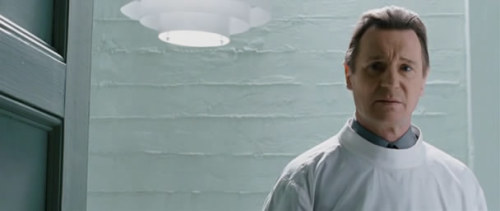A young woman, fleeing
from a break up with her longtime boyfriend, ends up in a head on collision
with a truck. The next time we see her, she's on a mortician's slab, being
clinically disrobed in preparation for burial. Suddenly, the woman's eyes open
and she asks where she is. The mortician, without batting an eye, calmly
informs her that she's in a funeral home - she was in a car accident. She's
dead. The young woman attempts to get off of the slab, but finds herself in a
paralyzed state, unable to move and held fast as the mortician cleans her
wounds and continues to calm her in a low, monotone voice that brooks no
argument to his words. He even shows her a death certificate - it all sounds
pretty convincing, right?
The main idea in
After.Life is trying to figure out whether the main character, Anna (played by
Christina Ricci), is alive or dead. The very fact that she's moving around
onscreen would probably be enough to convince the viewer that she's got a
beating pulse, but funeral director Eliot (Liam Neeson) seems to have an
explanation for every question. For one, he's the only person who can see her
as she is now - he's the only one who can see her soul, can speak to her and
help her adjust to her death in order to move on. Neeson definitely plays up
the charming sociopath, quickly growing exasperated with Anna's attempts to
escape the funeral home and denials of what he attempts to convince her are the
facts.
 |
| A man just doing a job...or something a little more sinister? |
It honestly might have
behooved the creators of After.Life to hold off of focusing on
Eliot in the
opening of the film, simply to give him a greater air of mystery because it
somewhat gives away the idea of whether or not he's the serial killer he seems
to be. After all, he's positioned quite well to both receive, incapacitate, and
eventually dispatch his victims as he sees fit. Ricci plays the damsel in
distress well, the walls of the funeral home acting as the veil between the
living and the dead that keep her and boyfriend Paul (Justin Long) apart.
There's a lot of visual metaphor going on here - the use of light and dark to
represent life and death, red against stark white to feel apathetic and removed
like how one might be treated in a hospital environment, and the previously
mentioned use of the building itself.
 |
| Red on white, for that cold, medical feel. |
The message behind the film can also be analyzed to remark on how the majority of people move through their lives - just going through the motions, being alive because that's what you do. Eliot feels it necessary to remove these people from existence, to give them the end they so obviously crave. Whether this is a noble mission or more justification for his sociopathic tendicies is something else that is left up for the audience to decide, but it certainly is a relevant idea: how many people really live their lives? How many of us are popping pills to make us feel a certain way? How many of us are unhappy? Finding things to identify with in films are often what makes them more memorable, and After.Life certainly hits home in that department. And once you're confronted with that idea - that you've not been living up to your fullest potential - would you fight for another chance?
 |
| Sounds a bit like Saw. |
The final climax of the
film certainly isn't a letdown, though whether it provides the desired answers
to the questions that the movie poses is another thing entirely. After.Life
certainly attempts to be a subtle film, giving vague clues that point the
viewer in the correct direction. It's my thought that, in the end, the creators
attempt to leave this film open for the viewers to decide what's the truth - if
Eliot really is a serial killer working in a funeral home, or if he truly can
speak to the dead and just happens to be incredibly creepy by keeping a cabinet
full of photographs of his "patrons". Even with its flaws, After.Life
is a unique film for someone who's looking for a little brain exercise with
their entertainment.


No comments:
Post a Comment